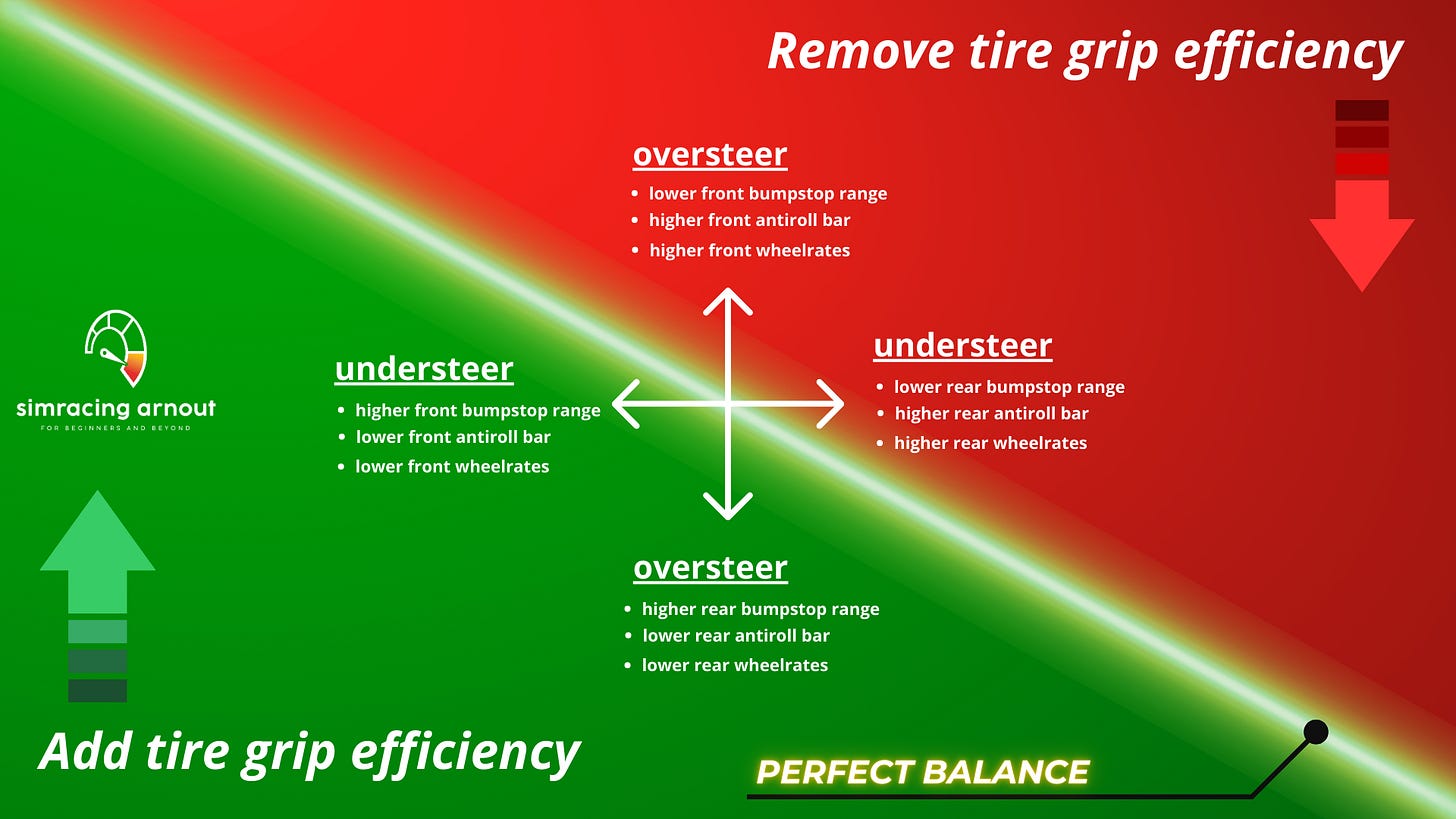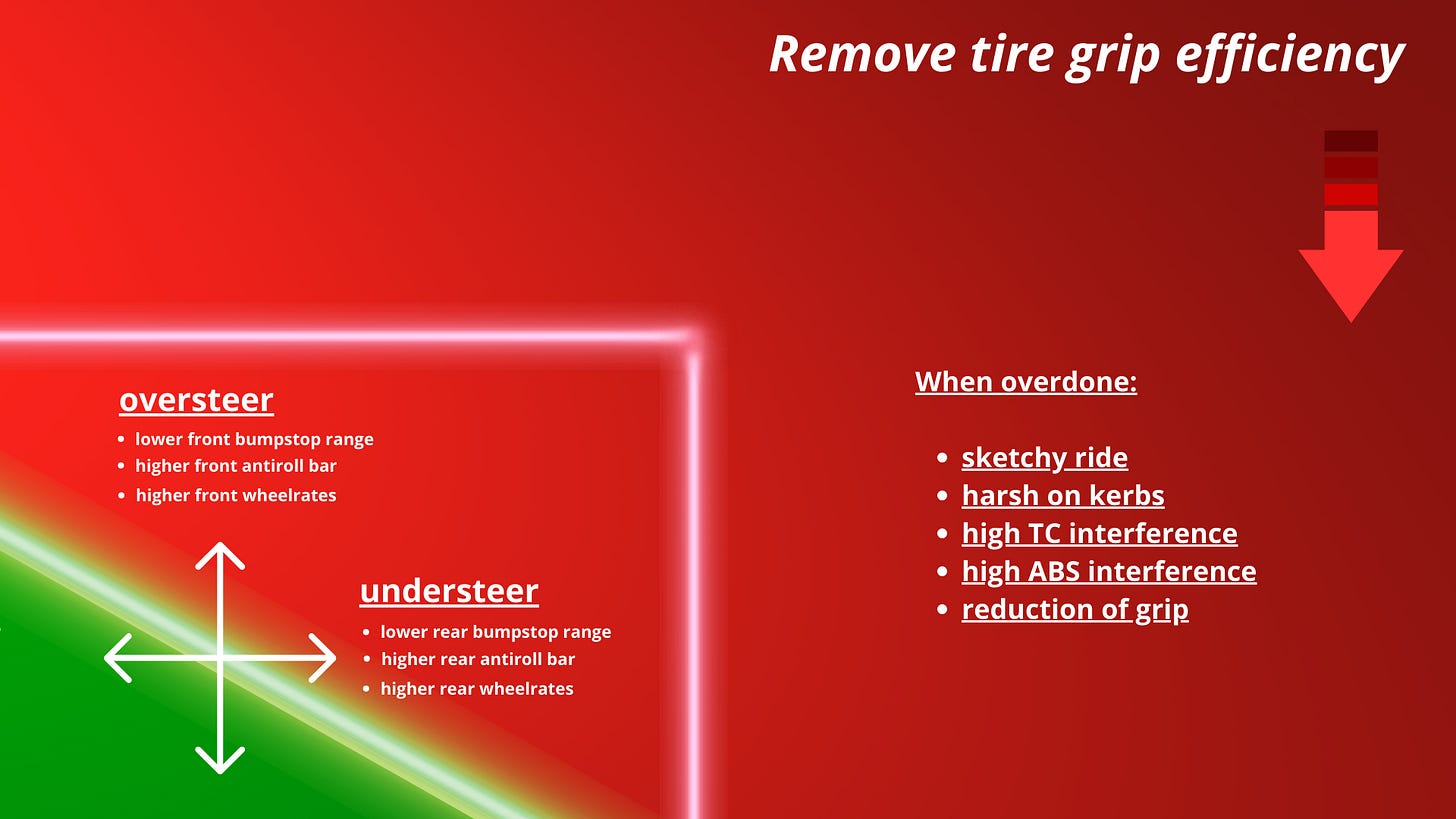Happy Tires: The Secret to Speed in Sim Racing
Being slow with your car in sim racing has multiple reasons.
The first and most important reason is how you drive.
Then, the car/track combination might be off; this car doesn't work on this track.
And, of course, the wrong car setup can hold you back.
But regardless of your car being slow on track or you not being able to drive your car faster, there is always something you can do about it:
Creating happier tires.
What are happy tires?
Nice, but what does that mean?
The four tires are all the contact you have with the track, and it's important to note that whenever you hear an F1 interview, they always talk about them—the tire this, the tire that, the heat, graining, etc.
Luckily for us sim racers, we don't have the variation of tires being different, as producing real tires can create small variations in how they feel.
But let's not go there.
A happy tire is a tire that can move in its suspension at all times. This means that if you brake hard, the suspension travels. You corner, the suspension travels. You hit a bump, and the suspension travels. You drive slowly on an uneven surface, and the suspension travels.
Think of it this way: Your tires are like your car's shoes. They need to flex and move naturally to grip the road properly.
The importance of suspension movement
Why is this so important?
If your suspension does not move when, let's say, you are braking hard, then the tire needs to move or the chassis of the car. The forces of the car’s body pitching need to go somewhere. If the suspension isn't capable of absorbing this movement, the tire will.
And by definition, that is creating an UNHAPPY TIRE.
When you apply pressure on a tire downwards, meaning you push the tire into the tarmac, you create tire load. There is a point where the tire will be able to generate more friction and traction, meaning you'll get more grip from that tire. When you brake hard in a braking zone, the front tires are under heavy load.
But what tends to happen in this situation is that it creates an OVERLOAD on the tire.
Imagine the tire contact patch getting bigger as we push the tire into the tarmac more and more, creating a larger contact area. But the reality is that the tire rubber deforms and loses its coefficient of friction because of it. As the load increases, you lose tire grip efficiency.
Understanding tire load - The simple version
Okay, let's look at it differently.
You press the tire into the road surface at 100 points of pressure. Let's imagine this was the optimal point of applying some pressure to create the best possible window of grip to the road surface.
Everything below would be considered not enough tire load, and anything above 100 would be considered tire overload, meaning we are deforming the tire and losing grip because of it.
We brake hard on track with stiff front springs and hard front bump dampers at high speed 250 km/h plus.
The chassis rolls forward slowly because of the hard springs and hard bump/compression damping.
But weight transfer did happen quickly; just the car and suspension didn't react that quickly. What happened here?
As soon as you slam on those brakes, the weight immediately transfers to the front tires, giving them 200 points of pressure.
The weight of the car needs to go somewhere, and the tire picks up the effect because the suspension is too stiff.
In simpler terms: Too stiff = unhappy tires because they're taking too much force too quickly.
The other extreme - Too soft isn't the answer either
Okay, Arnout, just soften the springs and dampers. This way, the tire can be more HAPPY.
Let's do the other extreme: We take the softest front spring and very soft front bump/compression dampers and create a situation where the suspension can travel when we brake hard.
Again, high speed brake hard and now the chassis moves immediately forward, the suspension travels quickly, yet we still get 200 points of pressure on the front tires.
Why?
The suspension was so soft that we are bottoming out. Meaning, we ran out of travel. Everything became so soft that the weight of the car pushed right through the suspension, hitting the bump stop or packer, and the rest of the load had to be picked up by the tire.
Creating, again... overload. an unhappy tire.
A good suspension creates happy tires.
So you need suspension travel at any given moment, and while it's not always possible, you need to compromise.
Finding your perfect balance
When you go soft on your suspension, meaning high spring travel, low bump values, low spring values, and low anti-roll bar values, you create happy tires under a slow driving situation but with a sacrifice in the fast corners.
Also, when you go stiffer with everything, you optimize for fast corners.
So, a good idea is to create a car with lots of suspension travel, low anti-roll bar settings, soft springs, and low bump values.
But the problem is that you suffer in fast corners. This means that it can be very tricky to drive; you might lose grip very inconsistently, you'll have a massive amount of body roll, the car under braking can be very oversteery, and when applying throttle, you can have massive understeer.
Yeah, you'll have happy tires but a horrible setup...
A meta esports setup.
The harsh truth about winning setups
The harsh truth is that with a GT3 car, you'll be a bit slower when you stiffen up your suspension. You create some unhappy tires in your setup to get a car to behave how you like. You hit the brakes, and the front tires overload a bit, so it doesn't SNAP on you when you enter corners.
You hit the throttle, and the rear tires overload a bit, letting the back of the car step out for a great exit.
Overall, you have a car that is just nice and safe to drive.
This solver shows how you can think about these changes:
You can reduce oversteer by adding tire-grip efficiency. This creates grip and makes a tire happy, resulting in a positive setup change.
But you can also remove tire grip efficiency—creating an unhappy tire—to create a positive setup change.
Bottom line:
Happy tires make you fast, but they don’t always result in a good car setup.
What to try next time
Next time you're setting up your car, try this approach:
✅ Start with softer settings than you normally would
✅ Test how the car feels in both slow and fast corners
✅ Gradually add stiffness until you find that perfect balance
Remember: The fastest theoretical setup is rarely the fastest drivable setup for most of us!
Cheers,
Arnout
PS.
Have you bought LMGT3 car setups lately? All the setups have updated TC and ABS settings; the next update will be rain setups, so always keep an eye out. Redownload the pack; this also counts for ACC setups. Click here to the store






